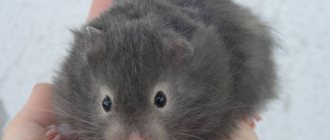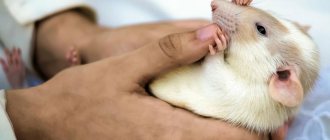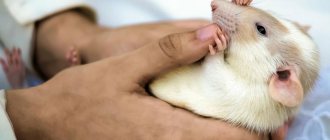- Neoplasms in internal organs
- Breast tumors
- Neoplasms on the skin, tumors of the subcutaneous tissue and bones
- Bone neoplasms
- What to look for
- How to reduce the risk of tumor development in your animal:
Decorative rats and pet hamsters live on average about two years in captivity.
Some absolutely healthy animals rarely live up to three years. The lifespan of a rodent is influenced by many factors, including heredity, care, balanced nutrition, and disease prevention. The older the rat or hamster, the greater the likelihood that the animal will develop a tumor of one kind or another. The cause of death for almost every mature rat at home is a malignant neoplasm.
The prerequisites for the development of tumors are bruises, falls, poor nutrition, and irregular sex life of our animals, which, naturally, is the result of keeping a rodent at home, because in nature, female rats can give up to eight litters a year, and hamsters - up to four.
Rodent tumors are divided into benign and malignant.
Benign tumors develop quickly in the body, but unlike malignant tumors, they do not metastasize, that is, they do not spread to other parts of the body. Typically, such tumors do not cause the death of the animal, but in advanced cases they grow to such an extent that it can no longer take care of itself normally. Benign tumors are almost always easy to remove surgically, and therefore the prognosis in this case is favorable.
Malignant tumors or cancer metastasize to adjacent tissues and organs. In small animals such as rats and hamsters, cancer in most cases affects the internal organs, and surgery becomes impossible. In this case, the animal lives out its life or, in advanced cases, it has to be euthanized.
Neoplasms in internal organs
In rats, tumors of internal organs are practically undetectable. Often they cannot be detected until the very late stage, and the symptoms of the disease are extremely vague. A specialist can palpate tumors in the abdominal cavity and do an ultrasound, but the most effective is a biopsy (taking material for cytology).
A caring owner should pay attention to any bloody discharge from the natural orifices of his pet: coughing with blood, sneezing, discharge from the vagina, urethra, feces with blood, blood in the corners of the eyes. Liver tumors lead to intoxication and weakness; intestinal lesions lead to defecation disorders, and in later stages, intestinal obstruction. If you notice such symptoms, immediately contact a specialist.
Treatment
Treatment of neoplasms of internal organs is carried out surgically; the specifics of the operation depend on the histological structure, location and stage of tumor development. Similar surgical interventions are performed in our clinic.
Symptoms
The animal must be taken to a veterinary clinic if it develops the following symptoms:
- the frequency of urination and defecation has changed significantly (up or down);
- strange scabs appeared on the surface of the rat’s skin, it began to look withered;
- the animal's fur is constantly disheveled and falls out in whole clumps;
- the rodent has stopped playing and is constantly trying to hide or lie down;
- the rat has lost its appetite and looks exhausted;
- when palpating the animal, you can feel dense lumps, swelling or bumps;
- periodically appear bloody discharge from the mouth, anus or urethra;
- the mucous membranes of the animal have an unnatural gray tint.
Even if you have several of these symptoms, do not try to make a diagnosis or choose a remedy at home yourself. The final verdict can only be made by a qualified veterinarian, who can prescribe treatment.
Breast tumors
Females are most prone to developing benign tumors of the mammary glands, although sometimes this disease is also diagnosed in males. The rodent owner can easily notice such tumors himself.
Fibroadenomas (fibro - connective tissue, aden - gland, oma - benign tumor) can be both soft to the touch and hard, sometimes even hard, like cartilage. Benign tumors of the mammary glands are encapsulated; a dense lump is usually palpable under the skin, sometimes several nodules at once. If the tumor is tightly attached to the underlying tissue, then this may be a sign of its malignancy. Most often, breast tumors appear under the armpits, as well as in the groin area and on the abdomen. The rate of tumor development depends mainly on the functional activity and size of the glands. Long-term hormonal disorders, false pregnancy, and lack of natural feeding of offspring contribute to the development of mammary gland tumors. Accordingly, normal functioning of the mammary glands reduces the likelihood of tumors developing on them.
A tumor of the mammary glands (mastopathy) can degenerate into a malignant formation with germination into the peritoneal wall, or it can go away without a trace. In any case, if you notice suspicious swellings on the chest and abdomen of your animal, you should contact a specialist.
Treatment
In the case of benignity and in the initial stages of cancer, the operation is not particularly difficult, and the rat’s chances of a complete cure and a quick recovery are high. In the later stages of tumor development, its radical excision involving surrounding tissue is required. The prognosis in this case is not always favorable: relapses and metastases may occur. In general, the operated animal can live for about another year.
How to treat
The tumor is detected using various methods, including ultrasound, x-rays, blood tests, as well as cytology and histology. In some cases, a doctor can make a diagnosis using solely the palpation method, but even then, additional studies are needed to definitively confirm the diagnosis.
Palpation helps to feel the boundaries and size of the tumor, as well as its effect on other body systems. For rats, surgical treatment of tumors is recommended. Conventional drug treatment is not practiced, since in most cases hormonal treatment simply does not bring the desired result.
Did you know? Rats survive even in the most difficult natural conditions. Their colonies have been found in abandoned stations in Antarctica.
How is the operation performed?
Surgery is the optimal method of getting rid of tumors in rats. It is dangerous and ineffective to carry out it only if the animal has numerous metastases. In addition, surgical intervention becomes impossible in case of brain tumors or if the animal has a number of other chronic diseases. In this case, the rodent may simply not survive the rehabilitation period.
The result of the operation largely depends on the stage at which the tumors were detected. If the nodes have just begun to form, a favorable outcome is almost guaranteed. The animal should not be allowed to become completely exhausted when the neoplasm grows throughout the body. A lot also depends on the age of the animal itself: a one-year-old rat will tolerate surgery much easier than its three-year-old relative.
You may find it useful to know what types of domestic rodents there are.
The tumor removal operation itself is performed in stages as follows:
- The doctor must conduct a complete examination of the rodent in order to understand what type of tumor needs to be treated, whether it is possible to avoid relapses, whether the rodent will survive the postoperative period or is it better to euthanize it. All this is also necessary to eliminate the possibility of abscesses.
- As for the direct removal of the tumor through surgery, this stage is performed exclusively by a qualified veterinarian and only within the walls of the clinic, so that all sterility conditions can be observed, as well as, if necessary, provide additional assistance to the animal. To anesthetize the process for the animal, a general anesthesia procedure is used. Additionally, drugs are injected into the bloodstream to stimulate the functioning of the heart and lungs.
- If the tumors are small, the doctor makes an incision in the skin and subcutaneous tissue, and then cuts out the affected tissue with a scalpel. The tumor must be removed along with the vascular pedicle and those healthy cells that are nearby.
- After this, that fed the neoplasm must be performed
- If the pathology has managed to grow and affect internal organs or glands, they are also partially removed.
- All that remains is to stitch up the wound in two stages. First, the specialist sutures the abdominal cavity and subcutaneous tissue using special threads, which tend to dissolve over time. Then the skin is sutured in the same way (only using silk thread). The doctor additionally leaves a small drainage at the bottom of the wound so that the exudate has somewhere to flow out.
Post-operative care
Immediately after surgery, the animal’s condition is extremely difficult. Over the next two hours, he may experience severe vomiting and uncontrollable urination or bowel movements. A rodent can be very aggressive or, conversely, lethargic. Loss of coordination and all associated factors are explained by severe pain shock. At this time, it is necessary for the rat to constantly have clean bedding (they must be replaced immediately when soiled) and fresh water. In the first three days after surgery, the rat should not eat any fermented milk products.
At home, the owner also needs to provide the rodent with maximum peace and comfort. During the first 24 hours after surgery, the rat will need a heating pad (for this you can use a regular plastic bottle with warm water). The owner also needs to monitor so that the animal does not begin to lick the stitches after surgery. To protect the animal, it is better to use a special collar around the neck, which will limit the animal’s access to parts of the body. Based on the recommendations of veterinarians, the wound should be treated with antiseptics and anti-inflammatory agents. A doctor should be responsible for removing stitches and monitoring the healing process.
Familiarize yourself with the behavior, care and nutrition of rats at home.
Bone neoplasms
A common bone disease in rats and mice is osteosarcoma. If the limbs are damaged, the animal stops actively moving and may even stop standing on its feet. When the skull and ribs are affected, a dense thickening on the bone is clearly palpable upon palpation. Osteoma can easily be confused with a bruise or arthritis, so the veterinarian makes a final diagnosis only after studying the results of cytology and x-rays of the affected area.
Treatment
Treatment of skin tumors and neoplasms of subcutaneous tissue is carried out exclusively by surgery. Timely contact with a specialist increases the animal’s chances of a complete cure. Osteosarcoma is a serious disease; most rodents cope poorly with it and die within six months.
Reasons for appearance
Experts have been studying the issue of the occurrence of cancer in animals for quite a long time.
During this period, it was possible to determine the main causes of the development of pathology:
- unbalanced diet, in which preference is given to fatty foods with preservatives and dyes;
- inactivity of the animal, for example, due to the small size of the cage or the lack of toys such as a swing, wheel, hammock;
- genetic predisposition in females, as well as heredity;
- the animal is in constant stress;
- mycoplasmosis.
What to look for
In order to promptly recognize one or another neoplasm in an animal, and accordingly, take measures to cure it, it is necessary to regularly examine the animal’s body. You should pay special attention to the following symptoms:
- The animal has become lethargic, loses appetite, weight, and has difficulty getting up from its place.
- Enlarged peripheral lymph nodes, local baldness, and the appearance of hernias.
- Impaired excretion of urine and feces.
- Refusal of food, general depression of the rodent's body, pallor of the mucous membranes.
All these symptoms may indicate cancer processes occurring in the rodent’s body, but you should not suspect a tumor for any single symptom. The final diagnosis should be carried out by a specialist after a comprehensive study; the owner’s task is to seek help in a timely manner.
Preventive measures
A tumor in a rat is not only a cause of severe pain and discomfort for the animal. Treatment of oncology in a pet is a real stress for a loving owner. To protect your furry from illness, tedious trips to the veterinary clinic and surgery, it is better to try to prevent the development of pathology. The main preventive measures include:
- Organizing a balanced diet for your pet . Moreover, it is necessary to provide the animal with proper nutrition from the first days of life. First of all, during feeding you need to exclude products containing harmful chemical compounds (dyes, preservatives, food additives). You will also need to diversify the rat’s daily menu with fresh fruits, berries, vegetables, lean meat, fish, seafood, and low-fat dairy products.
- Maintaining the animal's immune system . Most diseases, including cancer, develop against a background of weakened immunity. Therefore, every day you need to add a little specialized vitamin and mineral complexes to your food feeder to improve the health of rodents. For example, Shustrik, Farmavit Neo, Doctor ZOO, Calcium-D Myshild.
- Providing your pet with high physical activity . Moderate physical activity accelerates the animal's metabolism and also improves its health and endurance. To ensure that the rat always has a place to exercise, it is enough to install a play complex in the cage, including: a running wheel, ladders, ropes, labyrinths, tunnels.
- Protecting your fluffy from possible stress . Rats are social animals and feel depressed when alone. Therefore, it is recommended to have not just one pet, but several individuals of the same sex at once, so that they feel comfortable. You also need to protect the rat from frequent moves to a new place. When changing the owner, acquaintance should be carried out in stages, giving the animal time to adapt.
To avoid problems with your pet’s health, experienced ratologists recommend buying rats only from experienced breeders. Because a true professional who values his reputation takes care of his animals from birth.
Regardless of the cause of a tumor in a rat, examination of the animal in a veterinary clinic should begin as early as possible. Timely treatment will not only help rid the animal of the tumor, but will also return it to a full life.











